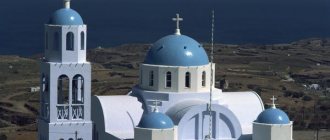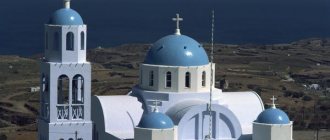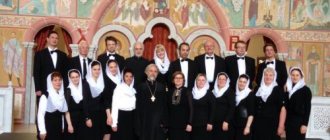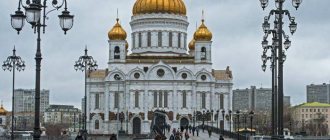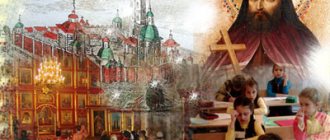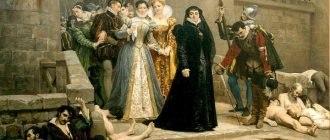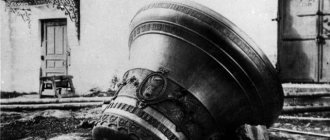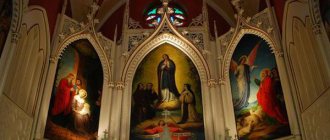| Historical building of the Holy Governing Synod in St. Petersburg |
The Holy Governing Synod
(Greek synodos - “gathering”, “meeting”, “cathedral”) is the highest body of church-administrative power of the Russian Orthodox Church, replacing the patriarch.
Not to be confused with the Holy Synod - an advisory body under the Patriarch.
Established on February 14, 1721. Abolished in 1917 in connection with the start of the All-Russian Local Council. Consisted of 79 bishops. Members of the Holy Synod were appointed by the emperor, and the Synod was governed by government officials - chief prosecutors.
Story
In 1718, Tsar Peter I first spoke about the need to change the structure of church government and create a Spiritual College. The tsar entrusted Bishop Feofan (Prokopovich) of Pskov (1681–1736), who was summoned to St. Petersburg back in 1716, to write the draft for the establishment of the Theological College. It was Theophan who from then on became Peter’s main assistant in carrying out church reform. The fruit of his labor was the Spiritual Regulations, compiled by 1720, and then read and corrected by the monarch himself. Theophan considered the main reason why the abolition of the Patriarchate was necessary the danger of the coexistence of two powers - spiritual and secular. "Ordinary people,
- said in the Spiritual Regulations -
does not know how spiritual power differs from autocratic power, and surprised by the glory and honor of the supreme shepherd of the church, he thinks that this ruler is a second sovereign, equivalent to the autocrat, or even greater than him, and that the spiritual rank is something else the best state."
Other reasons why church reform was necessary for its organizers were considered: firstly, that the affairs of church government under the “conciliar form” of government can proceed continuously, without being delayed by the illness or death of the Patriarch, and, secondly: truth is more quickly achievable with the participation of several persons in the management, and the decisions of the “council”, that is, the Spiritual College, will be more authoritative in the eyes of the people and less dependent on the influence of various strong people.
On January 25, 1721, the tsar issued a manifesto on the opening of the Theological College
, and on February 14 of that year its grand opening took place in St. Petersburg. However, instead of the Spiritual College, the new church authority then began to be called the Holy Synod.
For members of the Holy Synod, Peter I established a special oath, which included an oath of “faithful service” to representatives of the reigning dynasty, the obligation to “promptly announce... damage to His Majesty’s interest, harm and loss” and to keep official secrets. The hierarchs swore allegiance to the anti-canonical head of church power by a secular monarch (the “ultimate judge” of the Theological College). The oath existed unchanged until the beginning of the 20th century.
To exercise control over the Holy Synod, Peter, whom experience had taught not to trust his officials, created the position of Chief Prosecutor on May 11, 1722, ordering the selection of a “good man from among the officers.” The Chief Prosecutor was called “the eye of the sovereign” and “the attorney for state affairs.” He had at his disposal the synodal office and was obliged (according to instructions) to be “at the meetings of the presence” of the Holy Synod. During the Synodal period of church history, the position of Chief Prosecutor of the Holy Synod was occupied by thirty-four people.
Beginning in the 1740s, the importance of the chief prosecutor's power gradually increased, although chief prosecutors in the 18th century were figures with limited influence, which depended on the nature of the holders of this position and the degree of proximity of the ruling hierarchs to the Court. Under Emperor Paul I, there was even a unique case when the emperor, through the Archbishop of St. Petersburg Ambrose (Podobedov), authorized the Synod to independently elect a candidate for the post of chief prosecutor.
In the 19th century the situation changed dramatically. The chief prosecutors began to personally monopolize all information coming from the diocesan consistories, and actually imposed their decisions on the Holy Synod. Beginning with the reign of Emperor Alexander I, reports to the tsar were presented directly by the chief prosecutor - personal reports to the monarch by members of the Holy Synod ceased. Communication between the Synod and the supreme power began to pass through the chief prosecutor.
The power and influence of chief prosecutors especially strengthened during the era of Emperor Nicholas I under Count N.A. Protasov. He was the sole head of church administration. Under Protasov, on August 1, 1836, a special office of the chief prosecutor appeared, which was given the right to decide all matters related to church administration.
Under Emperor Nicholas II, the final legal formalization of the chief prosecutor's position took place: on January 6, 1901, the sovereign approved the opinion of the State Council, according to which the chief prosecutor of the Holy Synod received the right to be present “in the State Council, the Council of Ministers and the Committee of Ministers on an equal basis with ministers.” Thus, the rights of the chief prosecutor were equal to the rights of ministers.
At the same time, the chief prosecutor never had legal power in the Holy Synod, being, according to contemporaries, “the image and type of power without power itself,” its ghost. But having enormous powers, the Chief Prosecutor, just like the Holy Synod, could not be the complete master of the Church: “no one authorized him to manage
, wrote the last protopresbyter of the Russian army and navy, Georgy Shavelsky, “
and no one could recognize him as the owner.
He could destroy everything, no matter what the Synod created, but he could not create anything without the Synod. So the Church lived without a responsible owner, without a single guiding will.” This was all the more offensive to the Synod because back in the 18th century, at the request of Peter I, the eastern Patriarchs of Constantinople and Antioch recognized the canonical dignity of the Synod in a special letter dated September 23, 1723.
The Holy Synod had administrative and legislative power in the Church, having the right to issue definitions and legalizations on matters of faith, submitting them to the autocratic authorities for approval. The Holy Synod took part in the discussion of questions about the opening of new dioceses and vicariates, the establishment of new positions and theological educational institutions. He also determined the order of church life, the election of candidates for episcopal sees, the approval and dismissal of abbots and abbess of monasteries, the resolution of issues regarding the removal of holy orders and monastic ranks, the awarding of clergy, the opening of new churches and monasteries, the censorship of dogmatic and some other works, and witnessing. relics of saints, establishment of new holidays, religious processions.
The Holy Synod was in charge of the affairs of the “St. Petersburg Diocese of the Holy Synod” (or the St. Petersburg Synodal Region) until independent diocesan bishops appeared in it (see Synodal Region).
Initially, according to the “Spiritual Regulations,” the Synod was supposed to consist of twelve people. On January 25, 1721, the following were appointed to the Holy Synod: the president - Metropolitan Stefan (Yavorsky), two vice-presidents - Archbishops Theodosius (Yankovsky) and Feofan (Prokopovich), four advisers from the archimandrites and four assessors from the archpriests. In subsequent years, the composition of the Synod was repeatedly changed: in 1722, one adviser and one assessor were added to its members; in 1724, after the death of Metropolitan Stephen, the title of president was abolished, leaving two vice-presidents with six advisers and three assessors; in 1726 there were already eight advisers, two assessors and archimandrites called “for service.”
Since 1727, the previous titles (vice-president, adviser, assessor) are no longer found; they were replaced by the general expression “member of the Synod.” Bishops took seats in the Holy Synod in accordance with the seniority of their dioceses. In 1730, under Empress Anna Ioannovna, archimandrites and archpriests were again appointed to the Holy Synod (four bishops, three archimandrites and two archpriests), but since for a number of years the composition of its members was not replenished, by 1738 only one sat there bishop. Often decisions were made by only two synodal archimandrites and one archpriest. By the beginning of 1741, the Holy Synod had three bishops and three archimandrites. Under Empress Catherine II, in 1763, the Holy Synod was limited to six members (three bishops, two archimandrites and one archpriest).
The attitude of the supreme power to the Holy Synod and the empress's specific understanding of its functions is characterized by the available information that Catherine II, soon after ascending the throne, intended to appoint her future favorite G. A. Potemkin as a member of the Holy Synod. Potemkin received the assignment “to have his place at the chief prosecutor’s table” and was destined in the future “for an actual exercise in this place.” He had this place at the chief prosecutor's table for six years (from August 19, 1763 to September 25, 1769). However, nothing came of this initiative - secular persons did not get into the Holy Synod.
Since the beginning of the 19th century, archimandrites have ceased to be appointed to the Holy Synod. At the same time, according to a personal decree of June 12, 1805, diocesan bishops began to be involved in the meetings of the Holy Synod - in turn and for a period of one to three years. According to the staff drawn up on July 9, 1819, the Holy Synod was supposed to have seven people. The capital's bishop was called the leading member of the Holy Synod. The title of member was considered to be for life. After 1819, the Metropolitans of Moscow and Kiev became permanent members of the Holy Synod by virtue of their chair. The remaining hierarchs and priests who took part in the work of the Holy Synod were called present. In 1835, Emperor Nicholas I appointed his son, the heir to the throne, Grand Duke Alexander Nikolaevich, to attend the Holy Synod. The appointment of a layman caused a negative reaction from the Russian episcopate and, above all, Metropolitan of Moscow Philaret (Drozdov). This forced the Grand Duke to refrain from participating in meetings of the Holy Synod, but the very fact of such an appointment is indicative.
In general, since the time of Emperor Nicholas I, the secular authorities have carefully ensured that the composition of the Holy Synod changes more often, and since the second half of the 19th century it has become a tradition to appoint people to participate in meetings for two, rarely three years. After 1885 and until the reign of Emperor Nicholas II, representatives of the white clergy (archpriests and archpriests) were no longer appointed to those present at the Holy Synod. Under Nicholas II, representatives of the white clergy were admitted to the Holy Synod as an exception. At various times, it was attended by protopresbyters of the military and naval clergy, protopresbyters of the court clergy, and in 1908, Archpriest John of Kronstadt, who had all-Russian fame, was appointed to the presence.
| Session of the Holy Synod under the chairmanship of the smch. Vladimir (Bogoyavlensky), Metropolitan. Kievsky (in the center), to his left is Archbishop. Finnish Sergius (Stragorodsky). 1914-15 Photo from the Orthodox Encyclopedia |
By the beginning of the 20th century, the nominal leadership of the Holy Synod by the metropolitan metropolitan, the first-present member, had become the norm.
Throughout the entire Synodal history, there were only two exceptions to this rule - from the end of 1898 to 1900, the first present was the Kiev Metropolitan Ioannikis (Rudnev), and from the end of 1915 to March 1917, the Kiev Metropolitan Vladimir (Epiphany). The Metropolitan of St. Petersburg, like any bishop of the Orthodox Russian Church, was appointed “by decree of His Imperial Majesty.” The leading member of the Holy Synod presided over the meetings, led the debates, could in some cases influence their outcome, and could raise new questions (the other members of the Holy Synod were not deprived of this last right). But during the 19th century, the influence of the capital’s metropolitans on the course of church affairs was still constrained by political boundaries: he could not regularly communicate with the holder of supreme power on the grounds outlined by law. Only in February 1916, Emperor Nicholas II issued a decree granting the leading member of the Holy Synod the right to personally make reports to the Tsar on the most important matters. But due to inertia, Metropolitan Vladimir (Epiphany), who at that time was the leading member of the Holy Synod, did not take advantage of this right. From 1721 until the revolution of 1917, meetings of the Holy Synod were held three times a week: on Monday, Wednesday and Friday. During meetings in the Synod, bishops were not relieved of the administration of their dioceses, and during the era of Chief Prosecutor K. P. Pobedonostsev (in 1880–1905), the appointment of supernumerary bishops to the Holy Synod began to be practiced. For meetings, synodal members met for summer (from June 1) and winter (from November 1) sessions. Typically, fundamental problems were solved in the winter, minor ones in the summer. Of the permanent members of the Holy Synod, the Metropolitan of St. Petersburg sat continuously. The Metropolitans of Moscow and Kiev were usually summoned to the winter sessions. Often the direction of this or that synodal matter depended on the voices of these three metropolitans, for they, unlike the others, participated in the work of the Holy Synod without fail.
Changes in the personnel of the Holy Synod and the Chief Prosecutor's Office were made by the 1917 revolution. The provisional government, like the emperor once, introduced a new chief prosecutor to the ministers, who on April 14, 1917 obtained a decree from the new government on the release of all members of the Holy Synod and the appointment of new ones. The first post-revolutionary composition of the Holy Synod on April 29, 1917 stated that its main task was to facilitate the convening of the All-Russian Local Council. At the end of July 1917, the Holy Synod decided by its definition that, in view of the upcoming opening of the Local Council in Moscow on August 15, it transferred its work to the Mother See. The work of the Holy Synod in Petrograd was completed, and its members left the building of the Senate and Synod, in which synodal meetings had been held since the first half of the 1830s. Before that, the Holy Synod met in the building of the Twelve Colleges on Vasilyevsky Island in the capital. At the same time, on August 5, 1917, by decree of the Provisional Government, the Ministry of Confessions was established, which took over the affairs of the Chief Prosecutor's Office and the Department of Spiritual Affairs of Foreign Confessions of the Ministry of Internal Affairs. Before the transformation of the highest church administration by the Local Council, the Minister of Confessions, who became the last Chief Prosecutor of the Holy Synod in Russian church history, A. V. Kartashev, received the rights and responsibilities of the Chief Prosecutor and even the Minister of Internal Affairs (by affiliation).
In November 1917, at the Local Council, a patriarch was elected for the first time in 217 years. On November 17, 1917, the Local Council decided, among other things, from the day of his elevation to the patriarchal see in all churches of the Orthodox Russian Church to commemorate His Holiness instead of the Holy Synod, which followed from the patriarchal consecration on November 21 of that year. And on January 20, 1918, the Synod was abolished by a decree of the Soviet government, obviously as an old “political” department. On January 31 of that year, the Local Council decided that the newly established Holy Synod and the Supreme Church Council would take over the affairs of church administration from the Holy Synod from February 1. On the same day, the Holy Synod, accordingly, adopted its last Determination - No. 273 - “On the transfer of the affairs of the Holy Synod to the Most Holy Patriarch, the Holy Synod and the Supreme Church Council.” Thus, February 1/14, 1918 became the day of the abolition of the Holy Synod. At that time, the Patriarch of Moscow and All Russia, Saint Tikhon, noted the symbolism of this date: “On February 14, 1721, the Holy Governing Synod was opened and on February 14 (new style), 1918, it ceased its activities” [1].
Legal status
After the death of Adrian in 1700, Emperor Peter I decided to complete the church reform by creating a state body. In 1701, the emperor abolished the position of Patriarch and created the Holy Governing Synod.
According to its legal status, the Synod is the main state body of church and administrative power in the Russian Empire. The created Spiritual College completely replaced the Patriarch, performing his functions both within the Church and in all international relations.
In addition, the Council replaced the councils of local bishops, completely controlling all the activities of the Church. With the help of the created body, the government of the Empire could control the internal and external relations of the Russian Orthodox Church, managing it at its own discretion.
Important! This status was recognized not only by the clergy of the Russian Orthodox Church within the Russian Empire, but also confirmed and accepted by the Eastern patriarchs and autocephalous churches.
All members of the Collegium were appointed to positions by the autocratic government in the person of the Emperor, who in addition had an official representative in the Collegium - the Chief Prosecutor. The orders of the autocrat for the created body were not subject to discussion and were mandatory.
Reasons and purposes of creation
The main goal of Peter I, in addition to completely reforming the state foundations of the Russian Empire, was to concentrate all power in the hands of the emperor. It was for this purpose that he carried out a number of government reforms, and in 1700 he took up the work of the Church.
Since until this time the activities of the Russian Orthodox Church were completely subordinate to one person, the emperor and other state authorities had no control over it, so the goal of Peter I was the complete subordination of the Russian Orthodox Church. He wanted not just to rule, but to imprison her in the state administration apparatus and monopolize power.
In 1721, the Spiritual College was organized, which was called the Holy Governing Synod
The Spiritual College was formed to govern the Russian Orthodox Church and enable the emperor to make decisions on all internal and external issues. The formation and creation of the body took place according to the general rules of reform of executive institutions of the period 1717-1722, when collegiums were created instead of orders.
Functions
Since the Governing Synod was created instead of the position of the Patriarch, it concentrated its 2 main functions:
- Administrative - The Collegium dealt with issues of internal reorganization of the Church, spiritual enlightenment and regulation of rituals.
- Judicial - resolved controversial issues regarding the activities of clergy, church heresies and was the authority that defrocked and anathematized.
The Emperor gave the body the right to resolve all internal and external conflicts and issues, while directly controlling these processes. The Government Council performed the following work:
- election of bishops;
- establishment of new departments;
- appointment of bishops;
- regulating rituals and setting dates for holidays;
- implementation of censorship of all theological works;
- regulation of marriage;
- spiritual education of parishioners;
- canonization of saints.
The body dealt with all issues that were previously under the jurisdiction of the Patriarch (spiritual, government, monastic and palace orders).
Senior members
- Feofan (Prokopovich) (July 15, 1726 - September 8, 1736)
- Ambrose (Yushkevich) (May 29, 1740 - May 17, 1745)
- Stefan (Kalinovsky) (August 18, 1745 - September 16, 1753)
- Platon (Malinovsky) (1753 - June 14, 1754)
- Sylvester (Kulyabka) (1754 - 1757)
- Dimitri (Sechenov) (October 22, 1757 - December 14, 1767)
- Gabriel (Petrov) (September 22, 1770 - October 16, 1799)
- Ambrose (Podobedov) (October 16, 1799 - March 26, 1818)
- Mikhail (Desnitsky) (1818 - March 24, 1821)
- Seraphim (Glagolevsky) (March 26, 1821 - January 17, 1843)
- Anthony (Rafalsky) (January 17, 1843 - November 4, 1848)
- Nikanor (Klementyevsky) (November 20, 1848 - September 17, 1856)
- Grigory (Postnikov) (October 1, 1856 - June 17, 1860)
- Isidor (Nikolsky) (July 1, 1860 - September 7, 1892)
- Palladium (Raev-Pisarev) (October 18, 1892 - December 5, 1898)
- Ioannikiy (Rudnev) (December 25, 1898 - June 7, 1900)
- Anthony (Vadkovsky) (June 9, 1900 - November 2, 1912)
- Vladimir (Bogoyavlensky) (November 23, 1912 - March 6, 1917)
↑ The meaning of the Holy Synod
The establishment of the Synod opened a completely new era in the life of the Church.
- The Church lost its independence from government for almost 200 years
- The Collegium could quickly and easily resolve all matters, having greater authority than the patriarch
- The college was not dangerous to the sovereign, unlike the patriarch
- The growth of the Orthodox Church has increased almost 15 times over 2 centuries due to the activities of missionaries and church reform.
- The rise of theological education led to the establishment of 46 seminaries and 4 theological academies. The rise of church science has begun
- Extensive administrative activities were carried out in all directions. New churches and parishes were opened, liturgical books were published, etc.
Recommendations
- Ryazanovsky, Nikolai Valentin and Mark D. Steinberg. "The Reign of Peter the Great". Russian history. Vol. I. New York: Oxford University Press, 2011. 211-29. Print. pp. 215-219.
- Ryazanovsky, Nikolai Valentin and Mark D. Steinberg. "The Reign of Peter the Great". Russian history. Vol. I. New York: Oxford University Press, 2011. 211-29. Print. page 230
- Craft, James. Church reform of Peter the Great. Stanford, Calif.: Stanford University, 1971. Print pages 114–115.
- Craft, James. Church reform of Peter the Great. Stanford, Calif.: Stanford University, 1971. Print. p.137
- Craft, James. Church reform of Peter the Great. Stanford, Calif.: Stanford University, 1971. Print. page 141
- Ryazanovsky, Nikolai Valentin and Mark D. Steinberg. "The Reign of Peter the Great". Russian history. Vol. I. New York: Oxford University Press, 2011. 211-31. Print. pages 230-231
- Craft, James. "Diplomatic and bureaucratic revolutions, revolutions and resistance." Revolution of Peter the Great. Cambridge, MA: Harvard University Press, 2003. 60-65, 120-130. Print. p.62
- Craft, James. "Diplomatic and bureaucratic revolutions, revolutions and resistance." Revolution of Peter the Great. Cambridge, MA: Harvard University Press, 2003. 60-65, 120-130. Print. page 120
- Craft, James. Church reform of Peter the Great. Stanford, Calif.: Stanford University, 1971. Print.
- Krindach, Alexey. "Changing relations between religion, state and society in Russia." GeoJournal 67.4 (2006): 267-282. Print. page 269
- Craft, James. Church reform of Peter the Great. Stanford, Calif.: Stanford University, 1971. Print. page 175
- Ryazanovsky, Nikolai Valentin and Mark D. Steinberg. "The Reign of Peter the Great". Russian history. Vol. I. New York: Oxford University Press, 2011. 211-29. Print. pages 230-231
- Ryazanovsky, Nikolai Valentin and Mark D. Steinberg. "The Reign of Peter the Great". Russian history. Vol. I. New York: Oxford University Press, 2011. 211-29. Print. pages 230-231
- Craft, James. Church reform of Peter the Great. Stanford, Calif.: Stanford University, 1971. Print. page 153
- Craft, James. Church reform of Peter the Great. Stanford, Calif.: Stanford University, 1971. Print. p.165
- Craft, James. Church reform of Peter the Great. Stanford, Calif.: Stanford University, 1971. Print. pages 183 and 230
- Catholic Encyclopedia, Volume 7, Article by Adrian Fortescue, Publisher: Robert Appleton Company, 1910.
Composition[ | ]
Initially, according to the Spiritual Regulations, the Synod consisted of eleven members: a president, two vice-presidents, four advisers and four assessors; it included bishops, abbots of monasteries and members of the white clergy.
Since 1726, the President of the Synod began to be called the leading member
, and others -
members
of the Holy Synod and simply
present.
In later times, the nomenklatura composition of the Synod changed many times. At the beginning of the 20th century, a member of the Synod
was a granted title, held for life even if the person was never called to sit in the Synod. At the same time, the Metropolitans of St. Petersburg, Kiev, Moscow, and the Exarch of Georgia were, as a rule, permanent members of the Synod, and the Metropolitan of St. Petersburg was almost always the leading member of the Synod[1]:239. The special honor fell to Vladimir (Bogoyavlensky) to successively occupy all four of the mentioned departments since 1892 and therefore remain one of the four permanent members of the Synod from 1892 to 1917, and from 1912 to 1917. to be its Principal Member.
Literature[ | ]
- Gorchakov M.I.
Governing Synod // Encyclopedic Dictionary of Brockhaus and Efron: in 86 volumes (82 volumes and 4 additional). - St. Petersburg, 1900. - T. XXX. — P. 38-43. - Alekseeva S.I.
The Holy Synod in the system of higher and central state institutions of post-reform Russia, 1856-1904. - St. Petersburg: Nauka, 2003. - 276 p. - Alekseeva S.I.
The Holy Synod and the State Council in Russia (second half of the 19th century) // Pages of Russian history. Problems, events, people. Collection in honor of Boris Vasilievich Ananich. - St. Petersburg, 2003. - P. 10-16. - Alekseeva S.I.
Reform projects of the Holy Synod // Bulletin of the Orthodox St. Tikhon's University for the Humanities. Ser. II. Story. History of the Russian Orthodox Church. - 2005. - No. 1. - P. 5-23. - Alekseeva S.I.
The tradition of the “Symphony” and church-state relations in post-reform Russia // XVI Annual. Theological Conf. Orthodox St. Tikhon's Humanitarian University: materials. T. 1. - M.: PSTGU Publishing House, 2006. - P. 99-102. - Alekseeva S.I.T.I.
Filippov - official of special assignments under the Chief Prosecutor of the Holy Synod // Collections of the Presidential Library. Ser. "Electronic archive". Vol. 1. The Holy Synod in the history of Russian statehood: Sat. materials Vseros. scientific conf. with intl. participation. - St. Petersburg: Presidential Library, 2022. - pp. 115-130. - Alekseeva S.I.
Institute of the Synodal Chief Prosecutor's Office and Chief Prosecutors of the Holy Synod in 1856-1904. // Nestor. Quarterly thematic magazine history and culture of Russia and the East. Europe. Orthodox Church in Russia and the USSR. Sources, research, bibliography. - St. Petersburg; Chisinau: Nestor-Historia, 2001. - No. 1. - P. 291-310. - Babkin M.A.
The Holy Synod of the Russian Orthodox Church and the overthrow of the monarchy // Bulletin of St. Petersburg University. Story. - St. Petersburg: 2022. T. 62. Issue. 3. pp. 522-544. - Barsov T.V.
The Holy Synod in its past. - St. Petersburg, 1896. - 446 p. - Higher and central government institutions of Russia. 1801-1917. T. 1. / resp. comp. D.I. Raskin, resp. ed. N. P. Eroshkin. - St. Petersburg: Nauka, 1998. - pp. 134-147. - ISBN 5-02-028394-0; 5-02-028386-X.
- Zakrzhevsky A.G.
The Holy Synod and Russian bishops in the first decades of the existence of the “church government” in Russia // Nestor. Quarterly journal of history and culture of Russia and Eastern Europe, 2000. - No. 1. - P. 263-274. - Prot.
A. M. Ivantsov-Platonov. About Russian church administration. - St. Petersburg, 1898. - Kedrov N.I.
Spiritual regulations in connection with the transformative activities of Peter the Great. - M., 1886. - About the salary of members of the Holy Synod. Materials. / Message G. V. Esipov // Russian Archive. - 1870. - Stlb. 1953-1959.
- Prot.
V. G. Pevtsov. Lectures on church law. - St. Petersburg, 1914. - The Holy Synod in the history of Russian statehood: collection. materials Vseros. scientific conf. with intl. participation / scientific ed. S. L. Firsov, P. V. Fedorov. - 2022. - 738, [1] p.
- Smolich I.K.
Ch. II. Church and State // History of the Russian Church. 1700—1917 In 8 books. = Geschichte der Russische Kirche. - Leiden, 1964. - Tikhomirov L. A.
Monarchical statehood. — Part III. Ch. 35. Bureaucracy in the Church. - Tikhomirov P.V.
The canonical dignity of Peter the Great’s reforms on church governance. // Theological Bulletin, published by Imp. Moscow theological academy. - 1904. - No. 1 and 2. - Prot.
Georgy Florovsky. Paths of Russian theology. - Paris, 1937. - Shavelsky G.I.
Russian Church before the Revolution. - M.: Artos-Media, 2005. - P. 56-147. — ISBN 5-98574-011-0
Responsibilities
The Synod functioned in accordance with the statute of church regulations for the purpose of governing the church and reforming it. The charter stated that the eleven members of the college were to belong to different classes and ranks. The council consisted of one president, two vice-presidents, four councilors and four assessors, and each member received one vote when deciding a dispute.[15]
Formed as a reaction to Peter's views of Russia in comparison to Western Europe, the Synod was a concentration of clergy who had received extensive formal higher education. He worked to obtain as much of the disputed church property as possible, and after establishing control of the patriarchal area of the synod, he was responsible for the lives of 6,000 people. He was to be revered in absolutely everything and possess “patriarchal power, honor and authority.”[16]
The main responsibilities of the synod were to oversee the direction of the Orthodox faith, instruct the people on religious matters, celebrate holidays, and determine matters of order and ritual. As mentioned earlier, the Synod also suppressed heretics, judged miracles and relics, and prevented Russian citizens from practicing witchcraft. The Synod controlled church property and was thus responsible for the creation of monasteries and churches.[17]
Notes[ | ]
- ↑ 1 2 3 4 5 Tsypin V.A.
Church law. — Ed. 2nd. - M.: MIPT Publishing House, 1996. - 442 p. — ISBN 5-89155-005-9. - St. Zak. Main T. 1. Part 1. Art. 43.
- Decree of Emperor Peter I On the establishment of the Monastic Order ... (unspecified)
January 24 (February 4), 1701 - Decree of the Tsar and Grand Duke Fyodor Alekseevich “On the destruction of the Monastic Order” (unspecified)
. December 19 (29), 1677 - Decree No. 3718 // Complete collection of laws of the Russian Empire, since 1649. First meeting. - St. Petersburg, 1830. - Volume 6. - P. 314-346
- Published in the fall of 1721 under the title Regulations or Charter of the Spiritual Collegium, according to which it knows the duties of its own and all clergy, as well as lay persons, since they are subject to spiritual management, and, moreover, has to act in the administration of its affairs
: Decree No. 3718 // Complete Collection laws of the Russian Empire, since 1649. First meeting. - St. Petersburg, 1830. - Volume 6. - P. 314-346 - Decree of Emperor Peter I “On naming the Monastic Order of the Synodal Government as the Chamber-Office” (unspecified).
January 14 (25), 1725 - Memoirs of the comrade chief prosecutor of the Holy Synod, Prince N. D. Zhevakhov. T. 2. Ch. 51. The attitude of the Russian tsars to the church (undefined)
. Access date: January 30, 2014. - Shavelsky G.I.
Russian Church before the Revolution. - M.: Artos-Media, 2005. - P. 78, 87. - ISBN 5-98574-011-0 - Shavelsky G.I.
Memoirs of the last protopresbyter of the Russian army and navy.
Ch. XIX. Church affairs. Tobolsk scandal. (undefined)
. Access date: January 30, 2014. - Shavelsky G.I.
Russian Church before the Revolution. - M.: Artos-Media, 2005. - P. 486. - Quote From: "Government Bulletin". 5 () March 1916, No. 52, p. 2.
- A great act of trust. // "Moskovskaya Vedomosti". March 6 () 1916, No. 54. - P. 1.
- ↑ 1 2 Sapelkin N.
“He who sows sparingly will also reap sparingly” Archival copy dated July 1, 2016 on the Wayback Machine // Historical Truth, 01/30/2015 - The Orthodox Church and the coup d'etat. // “Church Bulletin, published by the Missionary Council at the Holy Synod.” 1917, April - May 14, No. 9-17. Stb. 181-182.
- “Church News published under the Holy Governing Synod.” April 22, 1917, No. 16-17. — P. 83.
- Gubonin M.E.
Contemporaries about Patriarch Tikhon. T. II. - M.: Orthodox St. Tikhon's Humanitarian University, 2007. - P. 220. - ISBN 978-5-7429-0303-1 - "Bulletin of the Provisional Government". 3 () May 1917, No. 46 (92). — P. 1.
- "Church News". 1918, No. 3-4 (January 31). — P. 22.
- "Moscow Church News". 1918, No. 3. - P. 1.
- Statehood of Russia. Book 4. - M.: Nauka, 2001. - P. 108. - ISBN 5-02-008746-7
- On the separation of church from state and school from church (Decree of the Council of People's Commissars) (unspecified)
. Access date: January 30, 2014. - Archived copy (unspecified)
(inaccessible link). Date accessed: July 12, 2022. Archived August 25, 2022. - Culture of the Leningrad region
